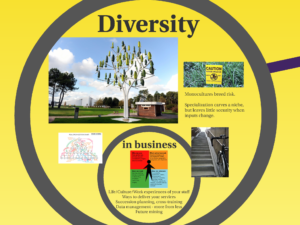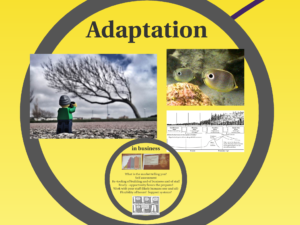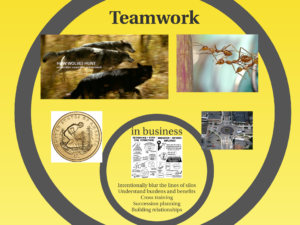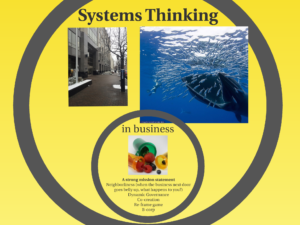Nature-Informed Business
I recently gave a presentation at Building Energy 2017 in Boston, called Redundancy, Diversity, Connectivity: optimizing your projects, your business, your life, and I was very pleased at the reception, so much so that I am going to share the basics with you. I plan to delve deeper into this approach over the next few months as I see so much value in this comprehension.
We are seeing great strides in the building industry in understanding nature’s lessons and in maximizing the synergies between what Mother Nature offers us and our “intrusions”. I have written about biosynergistic design, including biomimicry, biophilia, bio-remediation and bio utilization.
Biomimicry takes lessons from nature to inform innovations, primarily in products and in building or systems design. Examples include Velcro and night cooled buildings. Bioplilia is the understanding that humans benefit from ties to nature: experiential, cultural, implied. Bio remediation entails using nature’s residents to fix messes, such as sunflowers taking up lead from the soil, and oysters cleaning harbors. Bio utilization is about reconnecting nature’s systems, such as daylighting rivers previously trapped in pipes under cities, or recreating/ strengthening complex systems such as wetlands and river deltas.
All of this is profound and useful influence, yet I have found little, nearly nothing, on how nature ‘s lessons can inform business management and our entrepreneurial exploits. And I know there is much to learn. In each of the following few paragraphs I will explore a lesson from nature, and relate its knowledge to valuable use in business.

Nature benefits from diversity.
A healthy forest has coexisting flora and fauna and it is in interdependence that each element is healthy. Monocultures are incredibly risky. Take the example of agri-business farming with one crop type and one variety of that type. A single disease aggressor can wipe out the entire crop. We also know that diversifying investment is a safer bet. We see growing diversity in the energy industry when we start to decentralize and work toward locally placed electric generation. This diversity of the grid means fewer losses in transmission and a capability to maintain power in some places even with disruptions. There are also turbine trees and solar ivy that allow the production modules to move independently, meaning the system produces more often for an overall gain in production. We see diversity in space planning when a room can have many uses, and therefore have a higher percentage of use time, meaning less wasted space.
In business there is great potential benefit from diversity, but only if we understand, amplify and use the benefits of that diversity. Think of hiring staff with many experiences and connections and tapping into how they can connect your product or service to more partners and purchasers. How can you embrace a variety of work styles and support staff who do their best work at 10 am along with those who excel later in the day? Diversity in the structure of the business can break down dangerous silos, help with cross training and idea generation, as well as maintain a higher energy level. And diversity in your business line or in how you communicate and deliver your service or product means you can weather market shifts with confidence.

Nature is incredibly redundant.
In business this has become a dirty word even though we all know a business that doesn’t back up their files is a foolish one. Not so dirty an approach when you use it to create safety, reduce risk and prepare for a long-term flexibility. In our built environment we embrace this most clearly by synergies in systems and by modular approaches to powered elements. One large chiller may run at a small percentage most of the time, and that creates inefficient motor use. Having two to three smaller chillers means pulling one on-line only as demand increases and having the ability to decommission one for an upgrade or repair without affecting the building operations.
In business, think of cross training. Yes, you likely don’t need two employees to do the same job but when that fabled bus comes along, won’t you be glad that you indeed still have one?

Nature adapts.
One of the examples I found of nature informing learning process and business planning is
TREE by Michael Resnick of MIT Learning Labs. He cites a type of tree, the walking tree, that sends out roots to test soil, then, over time, strengthens those roots and lets lacking roots die off, eventually moving the tree toward the more beneficial grounds. This tree Tests Randomly, Evaluates, and Elects, which is one hell of a good business strategy.
Do you assess your market periodically? Do you watch the news and listen for new materials and new product legislation and new waste laws? Do you assess your staff pool of skills and interests and maybe even the performance of your competition? This information is key to adapting which is in turn key to keeping your business on a successful path.
From the lowly ant to the aggressive wolf pack, nature shows us ways species collaborate in their communities. Ants position themselves in a group mass to get across water and gaps in the path, and wolves not only hunt together, but have specific roles in the collaborative end-goal of gaining meat. Sometimes these roles change, when the forward harassing hunter tires, he may fall back to let another harry the beast.
In business, we often divide up our team so specifically we cannot truly collaborate across those silos, to the detriment of strong business management. I have heard stories of a sales force selling a product or service and misrepresenting the parameters of that offering. This creates a dissatisfied customer, the product looks like a failure, and the generation of a very good product becomes a liability in perception, affecting the success of that whole company. What about including the creators in the sales force? What about conscientious planning and then debriefing to understand the full cycle of the product including sales, ongoing service, and customer retention? What collaborations can occur within the business to engage your own staff in continued excellence? Think also about collaborations even across businesses. If the business next to yours in the downtown shopping area fails, how does this affect you? What collaborations will strengthen the community of businesses you are in?
This is the end all be all lesson of nature informed business. I told a story in a past blog about whaling and how Japan insisted that reducing whales would improve fishing success through removing the top predators. The big reveal was that even though whales eat fish their presence in the oceans stirs layers of water to increase nutrient access, and populations of fish are higher with whales in the mix. This translates into many situations.
We embrace systems thinking in the building industry through cradle to cradle certification and other methods of gauging inputs and outputs in production, such as EPDs (environmental product declarations). Language is a part of this. “Material management” is language that supports systems thinking as opposed to “waste management” or “garbage hauling” which are linear, and therefore wasteful. In your business are you aware of the materials and other inputs you are using? Do you know the source of information and products, and are you investing in stewardship of those resources?
Systems thinking puts more weight on education of staff and building relationships within the business and with other businesses. In the A+E realm, this means knowing the engineering firms, cost estimators, modeling teams that you work with, and not only using their skills well, but cultivating communications and processes so each job is easier to tackle than the last.
In your own business, this means seeing the market movement toward design performance modeling and getting designers excited about sketch-up, sefaira and other quick approaches to daylight, thermal and site modeling. It also means understanding the close-out of the work, and maybe recognizing there is no true close-out, but an opportunity for post occupancy evaluations that will inform the next project, the needed skills, the successes to celebrate, and the gaps to address.
Nature is, from the outside looking in, quite messy.
But in fact, if we allow nature to inform us and if we seek to understand our natural skills including interdependence, communication and curiosity, we will see the exceptional benefits in following her lead. Test Randomly by seeking knowledge widely from various people, different approaches and awareness of market influences. Evaluate what is of use to you and your work, looking not only at the current project or status quo, but the potential future state(s). Then Elect to adapt and learn, to re-engage and strengthen. And finally, grasp the power of systems and cyclic thinking so that you never rest on your laurels. We must do this work then redo it, over and over, for continued flexibility and success in a changing world. It is ever an inspiring opportunity to relearn, reassess, reposition, and recommit.
Repeatedly.
Thanks for being greener,
Jodi
3 Others like this post, how about you? (no login required)

